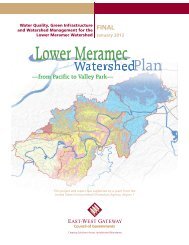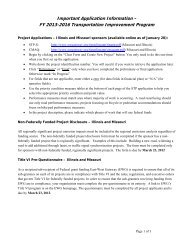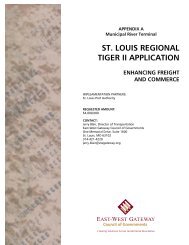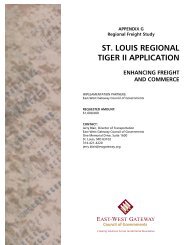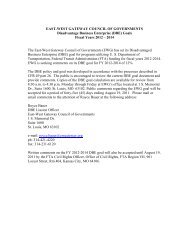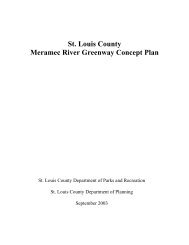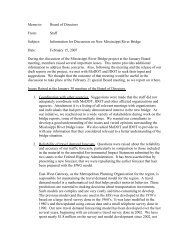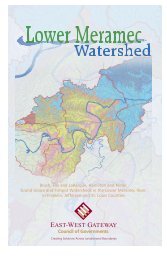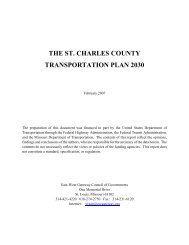Jefferson County - East-West Gateway Coordinating Council
Jefferson County - East-West Gateway Coordinating Council
Jefferson County - East-West Gateway Coordinating Council
Create successful ePaper yourself
Turn your PDF publications into a flip-book with our unique Google optimized e-Paper software.
6<br />
<strong>Jefferson</strong> <strong>County</strong> – Section 2<br />
of acres of productive farmland remained under water for weeks during the growing<br />
season. Rills and gullies in many tilled fields and large holes (exceeding 100 feet in depth)<br />
were the result of the severe erosion that occurred throughout the Midwestern United<br />
States farmbelt. The hydrologic effects of extended rainfall throughout the upper<br />
Midwestern United States were severe and widespread. The banks and channels of many<br />
rivers were severely eroded, and sediment was deposited over large areas of the basin's<br />
flood plain. Record flows submerged many areas that had not been affected by previous<br />
floods. Industrial and agricultural areas were inundated, which caused concern about the<br />
transport and fate of industrial chemicals, sewage effluent and agricultural chemicals in the<br />
floodwaters . The extent and duration of the flooding caused numerous levees to fail. One<br />
failed levee on the Raccoon River in Des Moines, Iowa, led to flooding of the city's water<br />
treatment plant. As a result, the city was without drinking water for 19 days.<br />
Hazard Event History<br />
The largest disaster to impact <strong>Jefferson</strong> <strong>County</strong> in recent years was the flood on 1993. Its<br />
size and impact was unprecedented and has been considered the most costly and<br />
devastating flood to ravage the U.S. in modern history. The number of record river levels,<br />
its aerial extent, the number of persons displaced, amount of property damage and the<br />
flood’s duration surpassed all earlier U.S. floods in modern times.<br />
The following gives an account of locations and areas that were affected by the inundation<br />
of water during the 1993 flood. Based on a workshop meeting held on October 17, 2003<br />
with <strong>Jefferson</strong> <strong>County</strong> officials and other community emergency management agencies, the<br />
following locations were specifically identified as locations that become flooded during<br />
various rainfall events. In DeSoto, Joachim Creek and North Main along Cedar Street<br />
became inundated from floodwaters in 1993 and flash flooding near the high school near<br />
Spross Memorial Park on Amvets Drive. In Festus, the community flooded in 1993 and has<br />
experienced problems with storm drainage and creeks. Also in 1993, Rock Creek in<br />
Kimmswick flooded Highway K, which was 33 feet under water and the Highway K Bridge<br />
was 35 feet under water. Other areas of <strong>Jefferson</strong> <strong>County</strong> experienced significant flooding<br />
at the confluence of the Big River and Meramec River, including Highway BB, <strong>West</strong> Old<br />
Highway 21, Highway 61/67 and Highway 55. Several areas in community of Arnold<br />
experienced significant flooding impacts from the 1993 flood, including Twin River Road,<br />
Big Bend Road, Meadow Drive, Riffle Island, State Road BB, and River Bend Acres. <strong>West</strong> of<br />
Pevely on Highway Z between Sandy Creek and Cherry Lane, 1993 floodwaters inundated<br />
the bridge; mitigation for this stretch entailed the raising of the road and replacement of<br />
the bridge. Refer to Figure J16 below.



